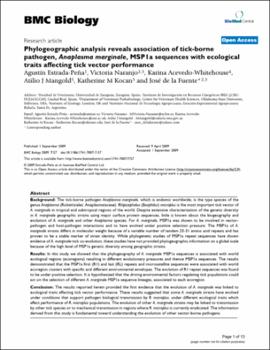| dc.contributor.author | Estrada-Pena, Agustin | |
| dc.contributor.author | Naranjo, Victoria | |
| dc.contributor.author | Acevedo-Whitehouse, Karina | |
| dc.contributor.author | Mangold, Atilio J. | |
| dc.contributor.author | Kocan, Katherine M. | |
| dc.contributor.author | de la Fuente, Jose | |
| dc.date.accessioned | 2018-11-09T21:10:43Z | |
| dc.date.available | 2018-11-09T21:10:43Z | |
| dc.date.issued | 2009-09-01 | |
| dc.identifier | oksd_estradapena_phylogeographi_2009 | |
| dc.identifier.citation | Estrada-Pena, A., Naranjo, V., Acevedo-Whitehouse, K., Mangold, A. J., Kocan, K. M., & de la Fuente, J. (2009). Phylogeographic analysis reveals association of tick-borne pathogen, Anaplasma marginale, MSP1a sequences with ecological traits affecting tick vector performance. BMC Biology, 7, Article 57. https://doi.org/10.1186/1741-7007-7-57 | |
| dc.identifier.uri | https://hdl.handle.net/11244/302046 | |
| dc.description.abstract | Background: The tick-borne pathogen Anaplasma marginale, which is endemic worldwide, is the type species of the genus Anaplasma (Rickettsiales: Anaplasmataceae). Rhipicephalus (Boophilus) microplus is the most important tick vector of A. marginale in tropical and subtropical regions of the world. Despite extensive characterization of the genetic diversity in A. marginale geographic strains using major surface protein sequences, little is known about the biogeography and evolution of A. marginale and other Anaplasma species. For A. marginale, MSP1a was shown to be involved in vector-pathogen and host-pathogen interactions and to have evolved under positive selection pressure. The MSP1a of A. marginale strains differs in molecular weight because of a variable number of tandem 23-31 amino acid repeats and has proven to be a stable marker of strain identity. While phylogenetic studies of MSP1a repeat sequences have shown evidence of A. marginale-tick co-evolution, these studies have not provided phylogeographic information on a global scale because of the high level of MSP1a genetic diversity among geographic strains. | |
| dc.description.abstract | Results: In this study we showed that the phylogeography of A. marginale MSP1a sequences is associated with world ecological regions (ecoregions) resulting in different evolutionary pressures and thence MSP1a sequences. The results demonstrated that the MSP1a first (R1) and last (RL) repeats and microsatellite sequences were associated with world ecoregion clusters with specific and different environmental envelopes. The evolution of R1 repeat sequences was found to be under positive selection. It is hypothesized that the driving environmental factors regulating tick populations could act on the selection of different A. marginale MSP1a sequence lineages, associated to each ecoregion. | |
| dc.description.abstract | Conclusion: The results reported herein provided the first evidence that the evolution of A. marginale was linked to ecological traits affecting tick vector performance. These results suggested that some A. marginale strains have evolved under conditions that support pathogen biological transmission by R. microplus, under different ecological traits which affect performance of R. microplus populations. The evolution of other A. marginale strains may be linked to transmission by other tick species or to mechanical transmission in regions where R. microplus is currently eradicated. The information derived from this study is fundamental toward understanding the evolution of other vector-borne pathogens. | |
| dc.format | application/pdf | |
| dc.language | en_US | |
| dc.publisher | BioMed Central | |
| dc.rights | This material has been previously published. In the Oklahoma State University Library's institutional repository this version is made available through the open access principles and the terms of agreement/consent between the author(s) and the publisher. The permission policy on the use, reproduction or distribution of the material falls under fair use for educational, scholarship, and research purposes. Contact Digital Resources and Discovery Services at lib-dls@okstate.edu or 405-744-9161 for further information. | |
| dc.title | Phylogeographic analysis reveals association of tick-borne pathogen, Anaplasma marginale, MSP1a sequences with ecological traits affecting tick vector performance | |
| osu.filename | oksd_estradapena_phylogeographi_2009.pdf | |
| dc.description.peerreview | Peer reviewed | |
| dc.identifier.doi | 10.1186/1741-7007-7-57 | |
| dc.description.department | Veterinary Pathobiology | |
| dc.type.genre | Article | |
| dc.type.material | Text | |
| dc.subject.keywords | normalize difference vegetation index | |
| dc.subject.keywords | tick species | |
| dc.subject.keywords | tick population | |
| dc.subject.keywords | tick vector | |
| dc.subject.keywords | high normalize difference vegetation index | |
